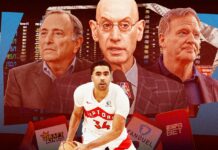LIVERPOOL, England — Jürgen Klopp and Jordan Henderson were the last two figures on the field. Manchester City’s players and staff members had applauded their fans, tucked away at one end of Anfield. Most of Liverpool’s had lingered longer, though only a little, to bask in the adulation of their public.
Now, though, it was just manager and captain, approaching the Kop, still in raucous voice, sufficiently energized that one might think Liverpool had just won a cup in springtime, rather than a league game — the 12th of 38 — played out in a biting winter chill.
Klopp raised his hands in thanks, then turned to leave. That was not enough for the television cameraman tracking his every move, though. There is a cliché shot of Klopp, one that tends to feature after every significant Liverpool victory: the German manager pumping his fists, one, two, three times, as the Kop cheers.
It is an image that neatly conveys the idea that Klopp is the bandmaster and Liverpool’s fans his orchestra: He sets the rhythm, and they play the tune. That was the shot the cameraman wanted, and the shot Klopp seemed to be denying him.
And so, wordlessly, he indicated to Klopp that he had forgotten something: three times the cameraman pumped his fists, as if to remind the Liverpool manager of his postmatch routine. This, here, was an image that neatly captured something, too: the relationship not between manager and fans, but between television and the sport it covers, where the medium controls the stories that are told.
Klopp looked faintly baffled at first, and then — reading his body language — a little angry. He made it clear that he was not going to perform for anyone, that he was not going to be taking instructions on how to celebrate the most important victory of Liverpool’s season so far, the most important victory since the Champions League final in June. He turned his back on the camera, to face his people once more.
Since Klopp arrived in England there has been a tendency to characterize him as, essentially, just a motivator: a megawatt smile and a bearhug, a shouter and bellower, a fist pumper and chest beater. Where his Manchester City counterpart, Pep Guardiola, for example, is seen as a tactical mastermind and philosopher, his eccentricity read as a sign that he understands soccer at some deeper level than everyone else, there are those who see Klopp as nothing more than a cheerleader.
That is the role he is expected to perform. It is what that shot of him, conducting the fans in the Kop, serves to reinforce. It leads to a conception of his Liverpool team as nothing more than effort and energy, a squadron of foot soldiers whipped up into a frenzy by the demagogue who commands them, garnished by three freewheeling attackers of prodigious improvisational brilliance.
It is time, perhaps, to address that conception. Liverpool does not sit eight points clear at the top of the Premier League, and nine ahead of Manchester City, the back-to-back reigning champion, because of Klopp’s charisma. It is not European champion because it is more motivated than all of its rivals.
It is not unbeaten at home in more than two years because Sadio Mané, Mohamed Salah and Roberto Firmino are enough to make up for a team that has little to recommend it beyond effort and application; it has not lost just one game in its last 52, or beaten a City team that is widely regarded as one of the best in history, 3-1, because Klopp can get the crowd riled up.
If any of that were true, Guardiola himself would not regard Liverpool as “the best team in the world right now,” its presence as “the greatest challenge” he has faced as a manager, or Anfield as “the most difficult stadium” in the world for any visiting team. He certainly would not — as he admitted in a talk at the University of Liverpool last year — find that he could not concentrate on reading a book because his thoughts kept turning to “Jürgen Klopp and Liverpool.”
Liverpool has not been turned into such a fearsome opponent by Klopp’s clever use of hugging. Liverpool is not, contrary both to popular perception and its own self-assessment, a team built on and driven by emotion. It is far more scientific than that. More than anything, what this Liverpool team has become — and what it may yet develop into — is a triumph of coaching.
It would be easy to see Sunday’s result and assume that City played badly, or that Liverpool was inspired, but that would not be the truth. The visitors were, as afternoon drifted into night, slicker and quicker and brighter. When Guardiola said he was “proud” of how his team had played, when he intimated he could not have asked for anything more from his players, he was not sugarcoating a bitter defeat. He had every reason to believe that his team came to Anfield and did all he asked.
The problem was that every aspect of Liverpool’s play is drilled with intense precision. Guardiola highlighted its set pieces, not only the corners and free kicks but the throw-ins, for which the club employs a specialist coach. He mentioned how, when a team sits back, Liverpool expertly opens the play through its fullbacks, Trent Alexander-Arnold and Andy Robertson, to create space.
He talked about the way Liverpool’s players pour into the penalty area. “Not just Mané and Salah and Firmino,” he said, but the midfielders, too: Henderson and Georginio Wijnaldum. It is not aimless running, either. “They arrive at exactly the right tempo,” Guardiola said. “It is almost impossible to live with this situation.”
And when an attack breaks down, in that moment of confusion and chaos that everyone in soccer now calls the “transition,” Liverpool melts back into its defensive shape seamlessly. “They are incredible going backward,” Guardiola said. Klopp’s team regroups, rejoins, and then starts hunting the ball again, ready to pounce on the counterattack.
That is not left to chance, either: Liverpool’s fabled front three are not given free rein to interpret attacks as they see fit. They run in set patterns, in predetermined directions, the fluidity that seems to come so naturally a product of intense work on the training ground. The very best teams — and this applies to City, too — do not really go in for freestyling. Everything, even attacking patterns, is planned.
With City, that has been obvious for some time; Guardiola’s team even has a signature goal, one that ordinarily ends with a cutback from Raheem Sterling for Sergio Agüero to tap in, that represents the culmination of all its coach’s hard work.
Increasingly, though, Liverpool does, too: one fullback switching the ball across the field to the other, a cross swinging in, three or four or five attackers speeding into different areas of the box to meet it. It reached its apex, perhaps, with Liverpool’s second goal here: Alexander-Arnold picking out Robertson from across the field; Robertson taking a touch, and finding the run of Salah. “I don’t think I ever saw a goal like that,” Klopp said.
It looked so natural that it was effortless. There is a tendency, in sports, to ascribe everything that seems easy to the virtuosity of the performers: to Alexander-Arnold’s natural vision, to Robertson’s accuracy, to a coolheadedness that Salah just happens to have.
It is a romantic story, an appealing one, one we can readily understand. The truth is less magical, less mystical. It is that Liverpool has practiced all of the component parts of that move again and again; that Klopp has drilled his players so intensely that he has reprogrammed their instincts.
It is tempting to think that Liverpool is soaring because of the man pumping his fist in front of the Kop, roaring his satisfaction, rousing them to war. It is soaring instead because of a man quietly plotting every aspect of his team’s performance, tuning his players to his needs. He is more strategist than motivator. It is just a shame that side of him is so much harder to capture on film.
Source : NYtimes












